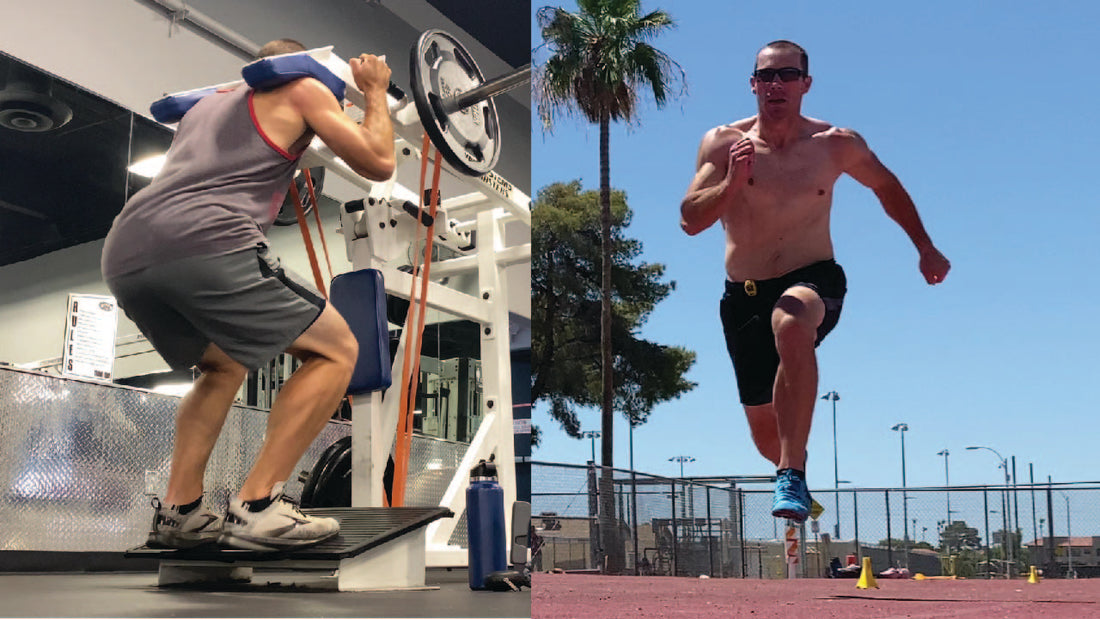3 Workouts For Sprinters
Here is an example of a few workouts for sprinters which can be performed during a pre-competition period. These workouts are primarily focused on the 100 meter dash, but can be useful for athletes competing in the 60 meter dash or the 200 meter dash.
Workout #1 - Acceleration Training
For the first workout, the focus is on developing skills, physical capacities, and specific conditioning for acceleration.
The workout was performed as follows:
- Track Warm Up
- 2x3x40yd from a skip-in or walking start.
- 2x3x40yd from a standing, 3 point, or 4 point start.
In total, 12 acceleration sprints are performed in the workout at a minimum of 95% effort.
This workout is mainly for well-trained sprinters who have significant experience performing acceleration workouts. Athletes with a lower training age (less experience) can perform this workout with less sprints or shorter distances per sprint.
For example, a female high school sprinter may do this workout to 25 meters and will likely benefit. Similarly, performing 6 to 10 sprints may be optimal rather than going for all 12.
This workout can be performed on its own, or with added exercises such as medicine ball throws or followed by a strength & power workout. In my case, I performed this workout as stated and waited until the next day to go to the gym.
Workout #2 - Strength Training
The second workout shown in this video was a strength training workout, focused mainly on developing rate of force development, joint stiffness, as well as some general strength training.
The workout was performed as follows:
- Contrast
- 6x3 Pin Squat Jumps (135lb to 275lb)
- 4x3 12" Drop to 2 Hops
- Bench Press - 3-3-3-1-1 to 275lb
- Hack Squat Drop Squats - 4x3 between 90lb and 140lb with two orange bands.
- 3x5 Pistol Box Squats with a 25lb Plate
The pin squat jumps were used with a start gun app to work on rapidly producing force similar to a block start, followed by the drop hops to work on quickly getting off of the ground and exhibiting joint stiffness.
Bench press was performed as a general strength development exercise. Personally I find that bench press helps with my block starts and accelerations, as well as for having a way to stimulate the CNS without tiring out my legs. Using a heavy, low volume bench press session prior to a competition can sometimes help people feel more wired and ready to go when they compete.
Hack squat drop squats were used to work on rapidly reversing out of the bottom position of a squat, which I believe is relevant for a first few steps following the block start. Being able to switch from the eccentric to the concentric is important for sprinters, and this is a way to train this quality under load.

Finally, the pistol squats to a box were performed as a general strength exercise targeting the rectus femoris, as well as challenging the body for balance and stability in the hip.
Overall this workout is not focused on developing higher levels of strength, but more as a way to take the strength you currently have and shift it toward being able to use that strength to rapidly produce force. The goal is not to get sore and tired, but rather stimulate the body and then go home.
Workout #3 - Speed Endurance & Resisted Sprinting
To cap off this 3 day cycle of training, the final workout was a mixture of resisted sprints and speed endurance training.
The workout was as follows:
- Track Warm Up
- 5x20m with the Exergenie
- 6x80m (40m Flying Sprints)
- 4x Overhead Backward Throws (6lb Med Ball)
- 4x Underhand Forward Throws (6lb Med Ball)
- 4x Supine Forward Throws (6lb Med Ball)
Because this was the third workout in a row this week, I used the resisted sprints as a way to improve my warm up and tune my brain into the feeling of sprinting. I feel like using resistance can help recruit more muscle more quickly than simply doing submaximal accelerations, and after doing the resisted sprints I felt much better able to perform the main workout.
The first couple 80m sprints were performed with a fast-easy-fast approach, where parts of the sprint were fast while others were more relaxed. For the last 4 sprints, the goal was to accelerate through 60 meters and then maintain those velocities for the final 20 meters.
Following the sprints, medicine ball throws were performed to work on general power and rate of force development outputs. Med ball throws are useful for teaching athletes how to project their body, how to transfer force through the body, and as a way to recruit a lot of muscle tissue in a movement that is somewhat relevant to the block start.
Conclusion
Hopefully seeing these workouts can help you get an idea of one way you can train at this point in the season. These workouts are better for athletes with a fair amount of training experience, as the volumes are somewhat high and the lifts are intense.
Less experienced athletes can perform the strength training workout here with more general exercises such as full range of motion squats instead of the pin squat jumps, and with stiff ankle hops instead of the drop hops.
Regardless, you can use these workouts to help guide you in creating your own training plan which targets acceleration sprinting, speed endurance, and rate of force development.
